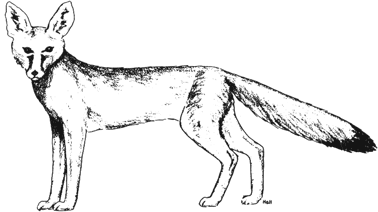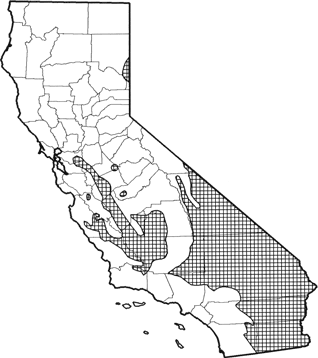
Kit Fox
Distribution, Abundance, and Seasonality
Uncommon to rare, permanent resident of arid regions of the southern half of the state (Grinnell et al. 1937). May still occur in eastern Lassen Co. Lives in annual grasslands or grassy open stages of vegetation dominated by scattered brush, shrubs, and scrub. The San Joaquin kit fox (V. m. mutica) is Federal Endangered and California Threatened.

Range Map
Specific Habitat Requirements
Feeding: Kit foxes primarily are carnivorous. The principal foods are black-tailed hares and desert cottontails, rodents (especially kangaroo rats and ground squirrels), insects, reptiles, and some birds, bird eggs, and vegetation (Egoscue 1962, Laughrin 1970, Morrell 1971, 1972, Orloff et al. 1986). They hunt by searching, meandering, circling clumps of brush, and wandering back and forth between clumps of vegetation. They stealthily approach larger prey, or prey in the open, then make sudden, swift rushes. They pounce on smaller prey.
Cover: Cover provided by dens they dig in open, level areas with loose-textured, sandy and loamy soils (Laughrin 1970, Morrell 1972).
Reproduction: Pups born in dens excavated in open, level areas with loose-textured soils.
Water: May not require a source of drinking water.
Pattern: Open, level areas with loose-textured soils supporting scattered, shrubby vegetation with little human disturbance represent suitable habitats for kit foxes. Some agricultural areas may support these foxes.
Species Life History
Activity Patterns: Active yearlong; mostly nocturnal, but often active in daytime in cool weather (Ingles 1965).
Seasonal Movements / Migration: Non-migratory.
Home Range: Little data available. In California, Morrell (1972) reported home ranges of 2.6-5.2 km? (1.0-2.0 mi?) for the San Joaquin kit fox. Considerable overlap between individual home ranges appears to occur (Morrell 1972). In Utah, Egoscue (1962) reported 0.19 kit foxes/km? (0.5/mi?) before birth of pups, and 0.48 per km? (1.25/mi?) after pups were born.
Territory: No data found.
Reproduction: Kit foxes usually are monogamous, but polygamy apparently also is common (McGrew 1979). Most pups born February through April, following a gestation period of 49 to 55 days (Egoscue 1962). One litter/yr of about 4 pups, range 1-7 (McGrew 1979). Pups weaned at about 4-5 mo. Males and females sexually mature in second yr. In Utah, Egoscue (1975) found a known-age individual of 7 yr at last capture.
Niche: Kit foxes use dens throughout the year. Nocturnal activity and regular use of dens are important adaptations for thermal regulation and water conservation (Golightly 1981). Potential predators are coyotes, large hawks and owls, eagles, and bobcats. Cultivation has eliminated much habitat. Kit foxes are vulnerable to many human activities, such as hunting, use of rodenticides and other poisons, off-road vehicles, and trapping.
Sources & References
California Department of Fish and Game, 1999.
California's Wildlife, Sacramento, CA.
Written by: G. Ahlborn, reviewed by: M. White, edited by: M. White, G. Ahlborn
California Department of Fish and Game. 1980a. At the crossroads: a report on the status of California's endangered and rare fish and wildlife. Sacramento. 149pp. Egoscue, H. J. 1956. Preliminary studies of the kit fox in Utah. J. Mammal. 37:351-357. Egoscue, H. J. 1962. Ecology and life history of the kit fox in Tooele Conty, Utah. Ecology 43:481-497. Egoscue, H. J. 1975. Population dynamics of the kit fox in western Utah. Southern Calif. Acad. Sci. 74:122-127. Golightly, R. T., Jr. 1981. The comparative energetics of two desert canids; the coyote and the kit fox. Ph.D. Diss., Arizona State Univ., Tempe. 174pp. Grinnell, J., J. S. Dixon, and J. M. Linsdale. 1937. Fur-bearing mammals of California. 2 Vols. Univ. California Press, Berkeley. 777pp. Ingles, L. G. 1965. Mammals of the Pacific states. Stanford Univ. Press, Stanford, CA. 506pp. Laughlin, J. M., and A. L. Cooper. 1973. A range extension of the kit fox in Oregon. Murrelet 54:23. Laughrin, L. 1970. San Joaquin kit fox: its distribution and abundance. Calif. Dept. Fish and Game, Sacramento. Wildl. Manage. Br. Admin. Rep. No. 70-2. 20pp. McGrew, J. C. 1979. Vulpes macrotis. Mammal. Species No. 123. 6pp. Morrell, S. 1971. Life history of the San Joaquin kit fox. Calif. Dep. Fish and Game. Wildl. Manage. Branch, Sacramento. 25pp. Morrell, S. 1972. Life history of the San Joaquin kit fox. Calif. Fish and Game. 58:162-174. O'Farrell, T. P., and L. Gilbertson. 1979. Ecological life history of the desert kit fox in the Mojave Desert of southern California. USDI Bur. Land Manage., Riverside. Draft Final Rep. 95pp. Orloff, S., F. Hall, and L. Spiegel. 1986. Distribution and habitat requirements of the San Joaquin kit fox in the northern extreme of their range. Trans. West. Sect. Wildl. Soc. 22:60-70. Snow, C. 1973. San Joaquin kit fox, Vulpes macrotis mutica and related subspecies, and the swift fox, Vulpes velox. USDI, Bur. Land Manage. Tech. Note No. 238. 24pp.
California Animal Facts | California's Wildlife